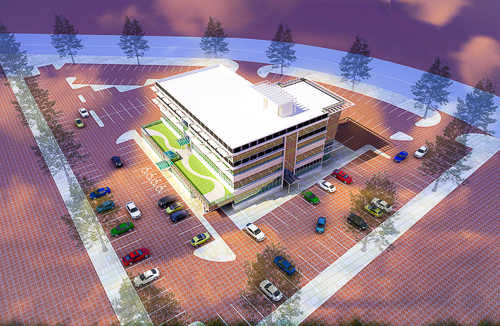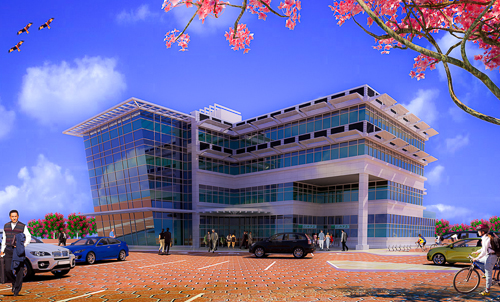(this is an article I wrote for UrbanToronto) We all know that going green is good for the environment, our health, and hopefully our pocketbooks. As much as it's important for us all as individuals to consider what kind of an environmental impact we make, it can be tough finding ways to make significant changes individually. As a group of people with similar interests—that being the UrbanToronto readership in this case—there may be more opportunities to participate in change if UrbanToronto takes the time to report on what’s happening in this arena.
With 20% of Canada’s greenhouse gas emissions coming from our buildings, a more fully involved development industry has the potential to effect a significant amount of positive change for our future. In addition to the environmental impacts, the corporate world has a sound financial case to strive for energy efficiency as well, for example reduced operating costs particularly in the face of the inevitable rise of fuel prices, and improved marketability and goodwill when the companies are perceived to be socially and environmentally responsible.
At all levels the government is supporting change as well, driving increasingly stringent building codes, supporting the uptake of energy efficient and renewable technologies, and adopting building performance standards like LEED or Toronto's Tier One and Tier Two Green Standards as optional construction paths.
Considering the inherent benefits to pursuing improved energy efficiency and environmentally conscious building practices, it makes sense as to why these two groups are active in this area. Knowing this, it may seem counter-intuitive that an energy distributor would be a source of financial incentives supporting builders in this pursuit, but that's the case. As part of its social responsibility and in support of a demand side management mandate implemented and governed by the Ontario Energy Board, Enbridge Gas Distribution has created a market transformation program it calls Savings by Design (SBD). This green building initiative is promoted to new construction builders and developers, constructing part 3 and part 9 buildings in the Enbridge Gas Distribution franchise area. As we sit squarely in the heart of this territory, the program could be "coming to a building near you", so we are learning about it and passing on the info, hoping to be a part of the change too.
Launched in January 2012, in collaboration with Sustainable Buildings Canada, the comprehensive Savings By Design program targets four key areas: energy, stormwater, resource use, and engagement. To help make higher-efficiency performance more attainable, Enbridge is providing funding and support during the design, construction and commissioning stages of projects. To qualify, projects must be in the planning or design phase, have a minimum aggregate area of 100,000 sf.
“This is something totally new that Enbridge Gas Distribution has never done before,” we were told by energy advisor Mary Sye, who developed the program in collaboration with manager Shannon Bertuzzi, several key stakeholders and business partners. It brings together owners and green building experts at the earliest phase of a project to explore a wide range of strategies, from resource conservation to renewable energy generation, and identifies the mix of technologies that can be incorporated into the design to maximize the building’s environmental performance.
The building is then modeled to estimate the potential natural gas and electricity savings, and a report is created. According to energy advisor and colleague, Carmine Faiella “At the end of the day, applicants have a picture of how much more efficient than the Ontario Building Code their proposed project is going to be.”
There's a lot to know about the program, and as UrbanToronto likes to get technical, we will be looking at various aspects of it over the next while, hoping to explain how this program should improve the buildings in which you will live and work in the future by looking at some of SBD's early adopters. For our initial installment, we were pointed in the direction of DCL Healthcare Properties Inc., the first company to take part in SBD.
Healthcare buildings are energy-intensive, making it a sector ripe for more initiatives that promote green thinking. DCL is trying to do just that. Its CEO, Frank Deluca, toured medical clinics in Romania, marveling that not only were they highly sustainable—certified to BREEAM Excellence, the world's leading design and assessment method for sustainable buildings—but they were built at one-third the cost of similar facilities in North America.
A visit to his own doctor’s uninspiring office in Ontario left Deluca with nothing to marvel about. He points to outdated and inefficient medical facilities, strained by the growing demands of an aging population. So, Deluca seized the opportunity presented by the SBD program to partner with municipalities in constructing clinics to take the burden off regional hospitals and, at the same time, showcase what is possible in green healthcare building design.
Now, DCL is developing one of the most highly performing, privately owned healthcare projects in North America. The project is aiming to achieve a number of industry firsts, including North America's first proposed BREEAM certified green medical office building. With over 250,000 green buildings certified to BREEAM globally and over a million registered for assessment, DCL could be set to lead a new charge in green building design for Canada.
DCL's business model is based on replicating an energy efficient standardized design in targeted growth communities across Ontario. Niagara Falls, deemed “prime for the Boomer Urban Exodus,” was selected as the site for the first DCL Medical Centre. Other locations being considered include Ajax, Oshawa, Ottawa, Stouffville, and a dozen more. Each clinic will be a “community healthcare hub,” occupied exclusively by medical service providers; general practitioners, dentists, opticians, pharmacy, laboratory and ultrasound facilities. “If we cluster functions within one location,” notes Deluca, “we already have a positive impact on the environment.”
The core configuration is a 4-storey, 50,000 sq ft structure that can be scaled up or down by adding or removing floors, depending on the needs of the local community. Integrated ‘smart’ building technologies will allow tenants to regulate temperature, lighting, communications, and security. For improved indoor air quality, it features operable windows for natural ventilation, low VOC interior finishes and UV technology for air scrubbing. “Tenants will immediately see the benefits,” adds Deluca. “But it goes beyond that because, as an owner, I am also interested in energy efficiency. Making the interior and exterior lighting system 100% LED has a huge advantage for us from an energy savings standpoint.” Other sustainable measures include geothermal heating and cooling, daylight harvesting (the building is 60% glazing), light shelves and Hempcrete walls.
DCL’s interests run deep because not only will it build the facility, but the firm will also own and manage its operations long-term. “Because I envision a 10 to 20 year holding period, I am very concerned about what I select to put in that building," says Deluca. “As the owner, there is a real motivation to make sure it is running at a high performance level.”
Enbridge facilitated an intensive brainstorming session called an Integrated Design Process charrette where a multidisciplinary team of industry experts evaluated the building proposal through the analysis of its form, materials, context and technical systems and then created a baseline model to illustrate its potential performance. They helped identify optimal solutions for improving energy efficiency, occupant health and comfort, as well as ecological benefits.
Deluca remarked on the success of the session, “You need an integrated team. Everybody has to be thinking together at the same level – ‘What’s our goal?’” Design improvements that resulted were numerous, including the shaping of the atrium in order to minimize heat build-up, strategically locating high performance glass, and, with Deluca’s encouragement, the decision to run an energy-saving variable refrigerant flow system on two of the four floors, instead of forced air. That type of HVAC technology is not typically used in healthcare buildings in Ontario. “We’ll use our facility as a giant test lab,” added Deluca.
When Deluca first heard about the SBD program, he was surprised. “Why would Enbridge give me the tools to figure out how to be that energy efficient? I commend them. I quickly learned there are a lot of smart, passionate people within that program who are trying to push the sustainable and high performance benchmark. I support it because it is a fantastic opportunity to have them on board, helping with this initiative, and I got to build a great team through the design process. Why not take advantage of all that available intellectual capital?”
The Niagara project is moving ahead quickly. With site plan approval and discussions with practitioners well underway, DCL is hoping to break ground by June, 2014. Other sites may not be far behind. The new medical facility not only advances sustainable building practices in healthcare but also seeks to far exceed targets and establish a new standard for ‘green’.
For more information on the Savings by Design program, visit the website http://www.savingsbydesign.ca/




